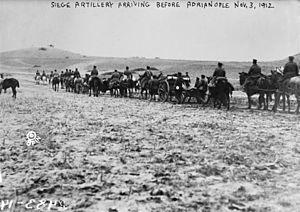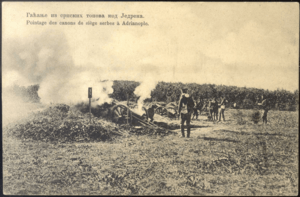Siege of Adrianople (1912–1913) facts for kids
Quick facts for kids Siege of Adrianople (1912–1913) |
|||||||
|---|---|---|---|---|---|---|---|
| Part of the First Balkan War | |||||||
 Siege of Adrianople |
|||||||
|
|||||||
| Belligerents | |||||||
| Commanders and leaders | |||||||
| Strength | |||||||
| 106,425 Bulgarians (424 guns); 47,275 Serbs (62 field guns, 34 howitzers) |
60,000 - 75,000 (Bulgarian claims) 52,597 (340 guns) |
||||||
| Casualties and losses | |||||||
| Bulgarian claim: ca. 7,000 killed and wounded Captured: 65,000 soldiers, 15 generals, 2,000 officers, 600 artillery guns, 16 flags Turkish claim: 13,000 killed and wounded 42,500 captured |
|||||||
The Siege of Adrianople was a major battle during the First Balkan War. It happened from November 3, 1912, to March 26, 1913. This important event ended with the capture of the city of Edirne (also known as Adrianople). The Bulgarian 2nd Army and the Serbian 2nd Army worked together to win this battle.
Winning the Siege of Adrianople was a huge success for the Bulgarian and Serbian armies. The city's defenses were thought to be "undefeatable." They had been designed by top German experts. But after five months of fighting, the Bulgarian army, with help from Serbia, took control of the city.
This victory was a big blow to the Ottoman army. It helped bring the First Balkan War to an end. A peace treaty was signed in London on May 30, 1913. However, the Ottomans took the city back during the Second Balkan War.
Bulgarian General Nikola Ivanov was in charge of the winning forces. General Georgi Vazov led the Bulgarian troops on the eastern side of the fortress. He was the brother of famous Bulgarian writer Ivan Vazov.
During the siege, airplanes were used for bombing for the first time. The Bulgarians dropped special hand grenades from planes. They hoped this would scare the Ottoman soldiers. Many young Bulgarian officers who fought here later became important leaders. They helped shape Bulgarian politics, culture, and business.
The Final Battle
The last part of the battle involved two night attacks. Soldiers covered their metal gear to avoid making noise or reflecting light. The armies worked together under one command. This was like an early version of a "front" in warfare.
Light cannons were pulled by horses to support the advancing soldiers. Efforts were made to block all Ottoman radio messages. This was to make the soldiers inside the city feel cut off and lose hope.
On March 24, 1913, the outer defenses of the city were captured. The next night, the main fortress fell to the Bulgarians. Early on March 26, 1913, the Ottoman commander, Mehmed Şükrü Pasha, surrendered. This officially ended the long siege.
After the surrender, some parts of the city were looted for three days. There are different ideas about who did the looting. Some say it was the Bulgarian army, while others blame the local Greek people.
A British war reporter described the Bulgarian army's success. He said that a small country with a small budget quickly put a huge army into the field. They marched far into enemy land, captured one fortress, and surrounded another. They won two big battles and reached the enemy capital. He noted that Bulgarians fought with a strong will to win.
Serbian units also played a key role. The Serbian 2nd Army was led by General Stepa Stepanović. They brought heavy artillery, including large cannons bought from France. The Bulgarians needed this help because they did not have enough heavy guns.
Serbian Soldiers Arrive
Serbian forces, led by General Stepa Stepanović, arrived on November 6, 1912. General Stepanović met with the overall commander, General Nikola Ivanov. The Serbian Second Army had about 47,275 soldiers. They also brought 72 artillery guns, many horses, oxen, and cars.
The arrival of the Serbian soldiers greatly boosted the spirits of the Bulgarian troops. Both Serbian divisions were sent straight to the front lines. One division covered a 15-kilometer area in the northwest. The other covered a 5-kilometer area in the west. A special cavalry group was formed to scout the area.
Images for kids















